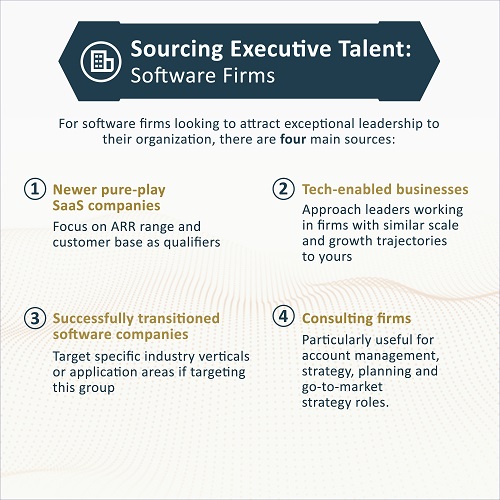Already super-charged by the pandemic and the associated demand for lock-down-related corporate software resources at home, the industry continues to grow by a double-digit compound annual growth rate; specifically, SaaS global revenues are predicted to almost double from 2020 levels by 2026 (from US$158 billion to US$307 billion).
Simplicity/ubiquity of deployment and pay-as-you-go are just some of the things that characterize the rapid adoption of SaaS products among enterprises of all sizes. Whilst concerns around data privacy, security, and a relative lack of flexibility to customize the software are factors that temper the SaaS market, the benefits of scale and cost-effectiveness have driven large-scale adoption.
The Software Landscape
The software products marketplace is broadly comprised of two types:
- Companies which started as on-premise, but have by now largely transitioned (with varying levels of success) to mostly SaaS, while still retaining an on-prem option for customers who want/insist on that option. Examples include SAP, Oracle, and Blue Yonder.
- Newer companies which are pure-play SaaS. This model started with companies like Salesforce, that quickly became a preferred alternative to on-prem CRM software, but have now grown to cover almost all major enterprise applications, including emerging areas like Contract Lifecycle Management and Spend Management. Firms like these are now originating not only from the Americas, but also Asia and Europe – for example, Freshworks, Icertis (India) and OneTrust (UK).
Outside of this vendor dichotomy, it is also important to note that there are also an increasingly large number of tech enabled companies that are in effect SaaS companies; many are B2C firms in areas like consumer services (e.g. Tripadvisor, Uber) and finance (e.g. Stripe, Tide, Starling).
The Big Talent Squeeze in the Executive Suite
There is clearly a three-way leadership talent war in the SaaS space, where traditional enterprise software companies who are transitioning/have transitioned to SaaS, are competing for top executive talent with born-in-the-cloud companies such as Salesforce, Workday or Marketo, who are also competing with internet companies such as Amazon, Facebook and Google.
It’s not an exaggeration to say that technical and executive roles at tech companies are more in demand now than they have ever been in human history, dwarfing the dot-com bubble. This will only increase as businesses continue to embrace digitalization, automation, AI, machine learning and data intelligence.
Evolving Capability Skill-Sets
For software product companies, people capabilities are evolving rapidly as their business and operating models further embrace cloud/SaaS offerings and its associated agility.
More than ever before, today’s software leaders need to operate with a mantra of continuous innovation, and to make real-time decisions based on client-base acceptability and usage, dropping products that do not work and improving what is working, fast. An ability to lead geographically dispersed teams is also critical, as SaaS companies can scale quickly by going global.
A SaaS platform also entails added complexity for finance and legal roles, due to the revenue recognition and matching of costs (e.g. cloud spends), as well as the establishment of legal agreements in multiple jurisdictions.
Business development functions in software companies have also evolved dramatically. The focus now is on annual recurring revenue (ARR), churn, account development (to maximize the number of users within a client), and the customer acquisition cost.
While a SaaS model still requires considerable end-user investment (transition, training, support, new business processes), this can be mitigated to a degree by the nature of the contract. The customer success function has evolved rapidly over the last few years to reduce churn and maximize usage, reversing the previous tendency of vendors to sell more product than the client required, resulting in shelfware (and larger sales commission payments). In some (but not all) SaaS vendors, customer success is also part of the sales function.
Sources of Executive Talent
A sophisticated and cohesive talent sourcing and engagement strategy is essential for software firms to attract A-grade leaders in the current climate. There are four main sources from which to search:
- Newer pure-play SaaS companies: SaaS companies run the gamut of early-stage outfits with significant potential upside through to established corporate players. In terms of the types of SaaS players to target as potential sources of executive talent, the ARR range and customer base are important qualifiers, as the people pool tends to be stratified around these variables.
- Tech-enabled businesses: the leadership pool across consumer tech, B2B tech, fintech, healthtech and edtech is large and talented and represents a rich source of executive talent for industry agnostic companies. These businesses are agile, customer-centric, and data-driven. The software firms that target this sector most successfully tend to align their talent hunting strategy (and which tech-enabled businesses they approach) in terms of their own scale, size and growth trajectory.
- Successfully transitioned software companies: firms that were offering purely on-prem solutions but have successfully transitioned to SaaS operating models are also good targets. This can be particularly fertile territory to find leaders who have led the adoption of a new business model. Target specific industry verticals or application areas if targeting this group.
- Consulting firms: not considered an obvious choice, we have found that professional services organizations that have worked closely with an extensive list of technology clients can sometimes be a valuable source of talent. This is particularly the case for functions like account management, strategy, planning and go-to-market.
A Compelling Proposition is Essential
Finally, booming industry conditions have made it exponentially more challenging to woo many executives to a new platform simply because they are enjoying so much success where they are. In order to spark interest and consideration, an opportunity must be extraordinarily compelling and presented in a way that is captivating, persuasive, thoughtful and personal to each candidate (the last part is often the hardest to get right, but when done well, has the most impact).
The recruitment challenge is especially true for companies that are in a ‘turnaround’ phase rather than pure growth companies. For organizations trying to rebound (often because they have challenges moving past legacy technologies or services), hiring an A-caliber CEO or GM first is critical to their ability to attract other high-level candidates into senior roles. Executive talent for software turnarounds is specialized and less abundant than ‘pure growth’ expertise.
The process for recruiting turnaround executives can be long and complex as a result of careful due diligence both hiring organizations and the firms’ Boards undertake of the hiring executive and vice versa. There is also commonly a very specific window or company phase during which a turnaround executive is not open to considering exiting a current commitment for even the most compelling opportunity.
Conclusion
The industry is growing at a super-charged pace. Software service providers and many tech-enabled businesses are vying for the same leadership profiles and skill sets. Hiring managers and/or their executive search partners not only need to understand the software industry and where successful executives are likely to be working, but to be as focussed and agile as the industry itself in their targeting strategy. Equally important is the ability to develop and present a compelling proposition to attract the best industry executives.









